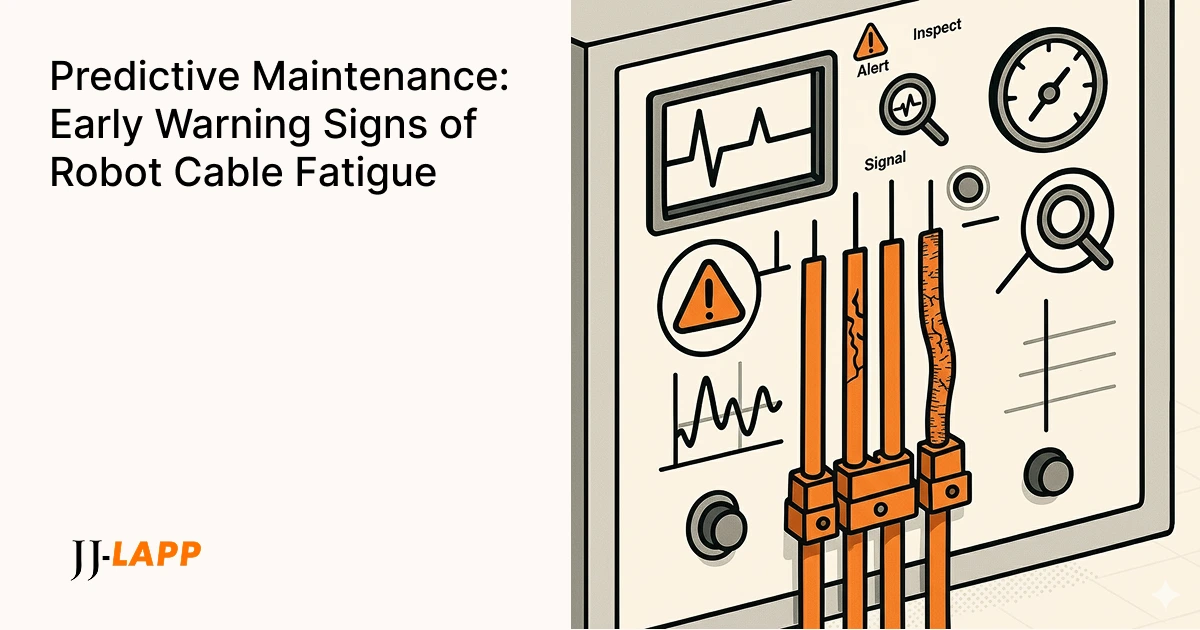The night shift calls—the main welding robot on your line in Vietnam is down again with a “position error.” Everyone assumes it’s a software glitch, but after hours of lost production, a maintenance tech finds a cable in the dress pack with a cracked jacket and visible braid scuffing. This wasn’t a sudden failure; it was the final stage of a long fatigue process that could have been predicted.
Robot cable failures rarely happen without warning. They leave a trail of subtle clues that a trained eye can catch long before a catastrophic stoppage. This guide helps your MRO team move from a reactive “fix‑it‑when‑it‑breaks” model to a proactive “predict‑and‑prevent” strategy for robot cable maintenance.
The High Cost of Reactive Maintenance on Robotic Lines
Running a cable to failure is expensive. A single unplanned stop on a critical robot can halt an entire production cell, damaging your Overall Equipment Effectiveness (OEE). The costs stack up quickly:
- Lost Production: Every hour the line is down is lost revenue.
- Wasted Labour: Engineers and technicians burn hours chasing faults that could have been anticipated.
- Collateral Damage: A failing cable can cause erratic movements that damage the robot, its end‑of‑arm tooling, or the workpiece itself.
A predictive‑maintenance programme turns these unpredictable costs into scheduled, budgeted events.
The Two Types of Warning Signs: Visual vs. Electrical
Predictive maintenance is all about tracking trends. For robot cable fatigue, those trends show up in two ways: physical signs you can see, and electrical degradation you can measure.
Visual Inspection: Physical Signs of Robot Cable Fatigue
Run a quick weekly walk-by and a deeper quarterly inspection. During planned downtime, look for these key indicators:
- Jacket Discolouration/Glazing: A jacket that looks shiny, bleached, or darkened in patches often signals heat or chemical exposure, which precedes embrittlement and cracking.
- Jacket Cracking or Abrasion: Cracks, cuts, or worn-thin areas are late-stage wear. Any breach is a critical failure point that allows moisture and contaminants to reach the core conductors.
- “Corkscrewing” or Longitudinal Deformation: A helical, pigtail-like shape is a classic sign of torsional distress and a strong predictor of imminent failure. It’s common when a non‑torsion‑rated cable is used on a twisting axis.
Electrical Inspection: Measuring Internal Degradation
Periodic checks and tests can reveal internal damage long before it’s visible.
- Continuity & Conductor-Resistance Checks: Measure each core end-to-end and trend the values. A rising resistance on a single core often points to strand breakage from fatigue.
- Insulation-Resistance (IR) Trend Logging: Log IR values between conductors and the shield. A downward trend over time suggests micro-cracks or moisture ingress reducing dielectric strength. Always isolate the cable from electronics before testing.
Tip: For encoder or hybrid servo/feedback cables, stick to low-voltage IR tests and always disconnect the device side to protect sensitive electronics.
The Proactive Solution: Why Purpose-Built Robot Cables Prevent Failure
These failure modes are what you see when a standard cable is used in a 6-axis robot’s combined bend-and-torsion environment. To prevent them, choose a torsion-rated cable family designed for dress-pack duty.
ÖLFLEX® ROBOT 900 P (power/control) is engineered for harsh robotic motion, with a torsion rating of up to ±360°/m and a design life of up to 5 million torsion cycles. Its features directly fight fatigue:
- PUR Outer Jacket: Resists abrasion, oils, and chemicals.
- Special Core Construction: Low-friction wraps let cores slide under twisting forces, reducing internal friction and preventing corkscrewing.
For applications requiring EMC protection, shielded ÖLFLEX® ROBOT 900 DP versions are also available.
Shop regional stock on the JJ-LAPP eShop (Indonesia):
- ÖLFLEX® ROBOT 900 P
- ÖLFLEX® ROBOT 900 DP
Need heat/spatter protection? Pair your robot cable with protective conduit and glands rated for your specific temperature exposure.
FAQ: Predictive Cable Maintenance
How often should we perform these checks? Perform a quick visual check weekly. Schedule a deeper visual and electrical check quarterly or semi-annually, depending on the robot’s duty cycle. The key is consistent logging to spot trends.
What is the single most important warning sign? For 6-axis robots, visible corkscrewing is the clearest sign that the wrong type of cable is being used. It’s a mechanical failure that will inevitably lead to an electrical failure.
Can we repair a damaged robot cable? Avoid splicing cables in high-motion applications. A splice creates a stiff, inflexible point that will fail quickly under bending and torsion. Always replace the full length with a purpose-built cable assembly.
The Bottom Line: Move from Reactive to Predictive Maintenance
With a simple inspection routine, you can catch problems early, justify the use of premium fatigue-resistant components, and schedule replacements on your own terms. This is how you protect your OEE and eliminate “mystery” robot faults for good.
Ready to get started? Contact us to receive our free Robot Cable Inspection Checklist & IR Trend Log templates. https://jj-lapp.com/contact-us/
*Local stock. German quality. Reliably Connecting ASEAN
